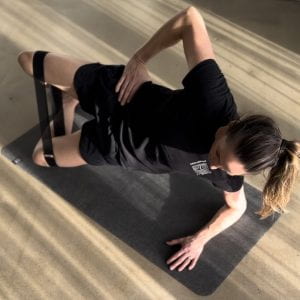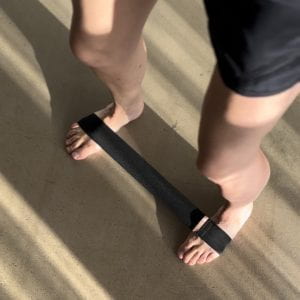This week’s blog post is written by one of our Physiotherapists, Henry Abrahams. As a Physiotherapist (MSc) and a Personal Trainer with a BSc in Sports Science, Henry also cofounded MoveWell, selling sustainable recovery fitness and rehabilitation products. Henry shares his knowledge on how micro-dosing strength exercises is a great way to incorporate strength work for runners, as well as the top three exercises you can do!
We often hear ‘build strength to improve your running’ and ‘your ability to recover’ but let’s be honest, it can difficult to find the time.
Enter ‘Micro-dosing’. A super easy and effective way to add strength training into your week. Micro-dosing is a physios favourite. It is often used when rehabilitating an injury, or for manipulating aspects of training. It is also a great tool when considering injury prevention (sometimes termed ‘prehab’) and general movement conditioning. But what is it? Essentially the term micro-dosing refers to the butterfly effect – where a small consistent stimulus leads to a greater overall impact. In this context, it’s a great way to incorporate strength for runners.
Why Strength?
It’s well understood that regular progressive loading, alongside effective nutrition and sleep can lead to strength gains. For runners, 1-3 strength sessions a week can offer the potential for performance and enjoyment gains, as well as offering broader health benefits. Perhaps most pertinently to runners these include joint, tendon and hormonal health gains. If you are new to strength training, even low doses a couple of times a week can start to make a big difference.
It’s ability to absorb force as we run, as well as produce force to drive us forward that increases our ability to withstand the demands of running both during a run and whilst recovering from the activity. And this is the key, quicker recovery means we are more able to get back out there and train effectively. Creating another stimulus, another opportunity for adaptation and ultimately doing more of what we love doing.
The key areas for runners to place additional focus on are the muscles that absorb and produce force at the ankle, hip and knee. Most notably the ankle and knee extensors. Namely, the soleus and quadriceps muscles. Targeting these muscles and the other muscles involved in running offers a great way for beginners and experienced runners alike to incorporate a strength training program.
What’s This ‘Micro-dosing’ All About?
Micro-dosing refers to small doses of exercise, usually administered regularly. In this instance bouts of strength exercises to help strengthen muscles. Small training stimulus, completed regularly can be a great way to drive tissue adaption and also and also to desensitise painful tissue. It’s a relatively easy and time efficient way to drive strength gains, help to reduce pain and increase relative function, with less potential for aggravating or inflaming the issue.
The key here is the simplicity and lack of barriers. It is well documented that interventions that are easy to fit in can help with adherence to a program, whilst creating a stress that evokes a positive tissue adaption be it for performance or rehabilitation.
 The same is true for injury prevention and movement conditioning exercises. If your hips are stiff they may affect your function elsewhere, simple exercises to improve strength and mobility around the hip joint that can be completed in a few minutes and at regular intervals, are far more effective and targeted, than one or two longer sessions in a week. In the end, it is consistency that is key! Research suggests that tagging exercises to pillars in your day leads to better adherence and good habit formation, which then leads to consistency and improved outcomes. This could be during your warm-up between runs – use the time wisely and your movement will thank you!
The same is true for injury prevention and movement conditioning exercises. If your hips are stiff they may affect your function elsewhere, simple exercises to improve strength and mobility around the hip joint that can be completed in a few minutes and at regular intervals, are far more effective and targeted, than one or two longer sessions in a week. In the end, it is consistency that is key! Research suggests that tagging exercises to pillars in your day leads to better adherence and good habit formation, which then leads to consistency and improved outcomes. This could be during your warm-up between runs – use the time wisely and your movement will thank you!
The tricky part is dose… how much and how hard. It can be good to adopt a strategy aiming for the minimal effective dose. Ultimately, it’s the ability to run, recover and repeat that improves performance. Strength training can make you sore and sometimes in the short term, reduce performance if you’ve over cooked it! The stimulus needed is hugely individual and dependent on a number of factors such as current health and fitness level, previous history of training, the type of running you are doing to name a few. Broadly speaking, aiming for some muscular fatigue is the key component. For those new to strength work, a single set working to 2-3 reps in reserve (before failure) could be appropriate, whereas the more experience strength trainer a higher set range, each up to 2-3 reps in reserve, is likely to be more effective. Another key feature is that as you adapt so too must the stimulus, usually through increased weight, or by playing around with speed and spending more time under tension during the lowing phase, or increasing contraction speed.
So, which Exercises do I do?
You could micro-dose any exercises but as described earlier in the key areas for runners to focus on are the knee and ankle extensors (in particular, quadriceps and soleus). Here are our top three suggestions for runners. You can progress the exercises by adding weight and regress them by adding support to take away load. To get advice specific to you, we highly recommend seeking input from a health professional, such as a Physiotherapist or Strength and Conditioning Coach with an interest in running.
- Single Leg Bridge
- Single Leg Bent Knee Heel Raise
- Bulgarian Split Squat
Give it a go, you won’t look back! Micro-dosing also works really well for mobility exercises and plyometrics but perhaps that’s for another day…
Find out more about our Sport Medicine Clinic and meet the rest of the team!
